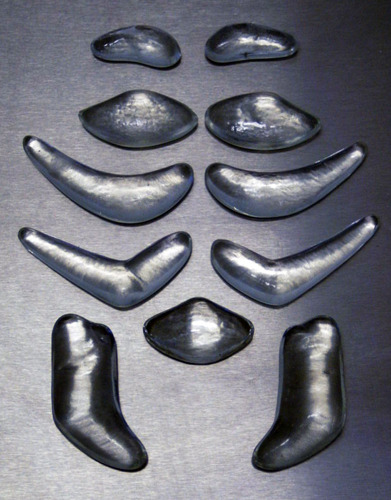Bioactive Glass Implants: Breaking the mould of Sci-Art Collaborations.
The research and clinical outcomes of the work conducted by Paddy Hartley and Dr Ian Thompson on Bioglass facial implant design and production are recognised as a landmark Science-Art collaboration and how artistic input can contribute towards practical and valuable clinical applications.
Origin
The origins of this unique collaborative project lay in the invitation extended to Paddy to present new work at the Victoria & Albert Museum in 2001 for the event ‘Short Cuts to Beauty’ which examined the beauty industry and cosmetic surgery. Paddy designed his first series of ‘Face Corsets’ for the event whose function was to mimic the results of popular cosmetic surgery procedures such as face-lifts and collagen injections. In the process of designing the work, Paddy was keen to incorporate commercially available facial implants into the garments and made contact with biomaterials scientist Dr Ian Thompson, then based at Imperial College London.
Dr Thompson was conducting research into casting small glass monoliths using a material known as Bioactive glass to act as facial implants to replace damaged parts of the skull. This unique material invented by US scientist Professor Larry Hench in the 1960's, was originally designed as a powder used to bond the shattered bone fragments of injured servicemen returning from the Vietnam War. Bioactive glass has the property of bonding to living tissue, thus tricking the body into thinking it is part of the host. It is the only man made material, which the body’s immune system will not reject.
Dr Thompson was using simple casting techniques to form the implants. Paddy’s expertise in mould making and casting brought new possibilities to the production of accurate, patient specific implants. This alongside Dr Thompson’s knowledge of facial anatomy presented the opportunity of a unique collaboration to further the development of Bioglass casting techniques and the development of the Face Corsets drawing from each partners knowledge base.
Bioactive Glass Facial Implant production gallery
Wellcome Funding
The partnership of Hartley and Thompson received a People Award from the Wellcome Trust to research casting techniques for the implants and to develop the Face Corsets as artworks. During the year long project at The School of Dentistry and Maxillofacial Surgery at Guy’s Hospital, the partnership created implants for 13 patients referred to Dr Thompson which were all successfully implanted. In parallel, Face Corset designs were exhibited in The Wellcome Trust Exhibition 'Future Face' at The Science Museum London. The work courted considerable media coverage and the research was formally presented at the inaugural Body Modification conference ‘Changing Bodies, Changing Selves’ at Macquarie University, Sydney Australia, 2002.
Dr Thompson continues to explore and develop the applications of Bioactive glass, whereas the collaboration prompted Paddy to devise his next Wellcome funded initiative 'Project Facade', examining the origins of facial reconstruction during WW1. Post Project Facade, Paddy revisited his original Face Corset designs with high fashion applications.











